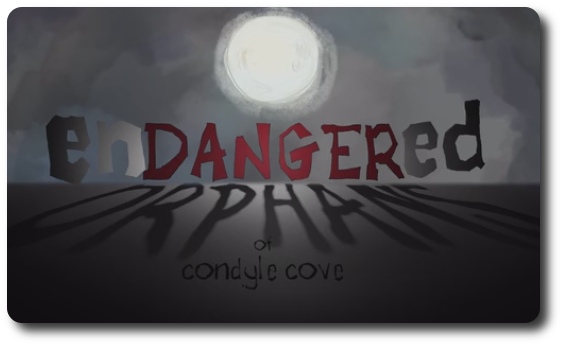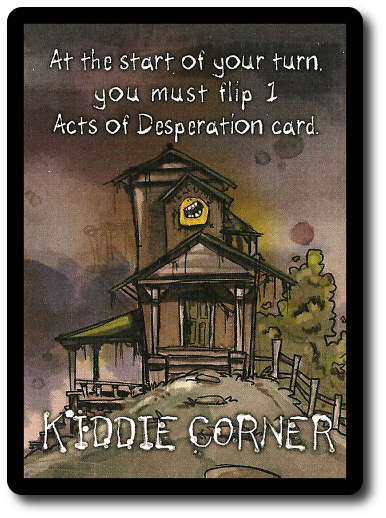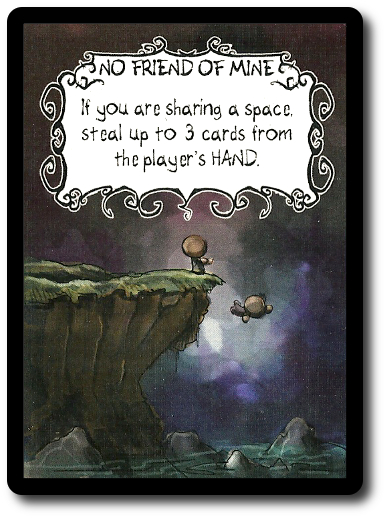Please Take Note: This is a review of the final game, but it might change slightly based on the success of the Kickstarter campaign. The game is being reviewed on the components and the rules provided with the understanding that “what you see is not what you might get” when the game is published. If you like what you read and want to learn more, we encourage you to visit the game publisher’s website or visit the Kickstarter campaign. Now that we have all that disclaimer junk out of the way, on with the review.

The Basics:
- For ages 8 and up
- For 2 to 3 players
- Approximately 20 minutes to complete
Geek Skills:
- Counting & Math
- Logical & Critical Decision Making
- Reading
- Strategy & Tactics
- Risk vs. Reward
- Hand/Resource Management
Learning Curve:
- Child – Easy
- Adult – Easy
Theme & Narrative:
- God save the little orphans…
Endorsements
- Gamer Geek approved!
- Parent Geek rejected!
- Child Geek rejected!
Overview
Children naturally look for love and protection. When neither is available, a child will either wither or grow strong and strike out on their own. The orphans of Condyle Cove are being hunted by a monster and many have gone missing. The last remaining children now take to the streets in one last desperate attempt to survive. Talk about a “hard-knock life”, eh?
Endangered Orphans of Condyle Cover, designed by Jesse Labbe and to be published by Certifiable Studios, will reportedly be comprised of 38 Option cards, 1 Cul De Sac/Kiddie Corner card, 9 Cove cards, 6 Acts of Desperation cards, 4 Detour cards, and 3 Orphan markers. The illustrations, also by Jesse Labbe, are dark and slightly disturbing, suggesting violence, fear, and horror all at once. If “hope” was a color, it wouldn’t be found in the card illustrations.
Something Wicked This Way Comes
To set up the game, first shuffle the Option cards (with the Detour cards) and place them face-down to create the Options deck. Leave room for a discard pile.
Second, give each player 2 Option cards. This is the player’s starting hand.
Third, shuffle the Acts of Desperation and Cove cards separately. Place each face-down to create the draw decks.
Fourth, place the Cul De Sac (Kiddie Corner) card face-up in the middle of the playing area.

Fifth, draw the first 4 Cove cards and place one on each side of he Cul De Sac card creating a plus (+) configuration. Assign each player an Orphan marker and place them on the Cul De Sac card or on any of the other 4 Cove cards.
That’s it for game set up. Determine who will go first and attempt to survive.
The Amazing Short Lives of Orphans
Endangered Orphans of Condyle Cove is played in turns with no set number of turns per game. A game turn is summarized here, but a player can also play cards out of turn, canceling opponent cards and being a general nuisance.
Step 1: Move Orphan
The player may move their Orphan marker up to 2 spots (cards) or decide to stay on the spot where they are currently located.
Step 2: Play Option Cards
The player may now play as many Option cards from their hand as they like. Played Option cards are placed in the Option card discard pile.

There are 4 different types of Option cards. Each are summarized here.
Action Option Cards
“Action” Options cards allow the player to do exactly what the card suggests: take an action.
Attack Option Cards
Combat is not really a good idea, but when push comes to shove, an orphan will have to either fight back or be gone forever.
Defense Option Cards
“Defense” Option cards cancel the effects of other Option cards, be they targeting the player or not. Once played, the Option card is canceled for good, however, a “Defense” Option card can cancel another “Defense” Option card, thus nullifying the effect. “Defense” Option cards can be played at anytime and out of turn.
Detour Option Cards
The “Detour” Option cards allow the player to swap the position of different Cove cards to either benefit themselves or to make life all the more difficult for their opponents.
Step 3: Draw Cards
The player must draw 2 cards, either 2 Cove cards, 2 Option cards, or 1 card of each. Cove cards are placed adjacent (not diagonal) to other cards attached to the “Cul De Sac/Kiddie Corner” Cove card. Option cards go to the player’s hand, but a player may not have anymore than 4 Option cards in their hand at one time.
Cove Cards
Cove cards represent the different locations around Condyle Cove the orphans are running to in hopes of hiding from the boogeyman. No kidding. The kids are being chased by some dark and shadowy figure. How creepy is that? If a player comes across the boogeyman, their Orphan simply disappears from the game, meaning the player and the orphan have lost. More so the orphan.

None of the locations around Condyle Cover are warm and inviting. Every spot feels dangerous and eager to harm. However, orphans can make use of these dangerous places and obtain a few perks that will help them survive for just a little bit longer. Caution should be taken, however, as the better the perk, the more dangerous the location.
Acts of Desperation
If the player takes their Orphan marker back to the center of Kiddie Corner, they are forced to take an action, as instructed by the spot they landed on. In this case, drawing an Act of Desperation card. This is, as defined by he game rules, “Boogeyman Russian Roulette”. Which is to say, the player will be drawing a card at random. If it’s the boogeyman, they have lost the game. If it isn’t, their orphan survives for another turn, at the very least. Why take such a risk? If the player can avoid the boogeyman for long enough, they’ll have more options to survive. Either way, it’s a gamble.

Survival = Victory
When a player runs out of Options, so too does their orphan. The boogeyman reaches out and snatches them. The poor orphan will never be seen again. Alive, at any rate. As long as a player has Options, their orphan can maneuver and avoid danger. The last player who still has a safe Orphan wins the game.

To learn more about Endangered Orphans of Condyle Cove, visit the game publisher’s website or visit the Kickstarter campaign.
Final Word
 This game really bothered the Child Geeks. I’ve played games with them before where the artwork is a bit too graphic to be acceptable for young players and with themes that are fairly intense. This game seemed to touch something inside the Child Geeks that they just couldn’t shake off. According to one Child Geek, “I guess it’s what the game is about that I don’t like. I don’t like the idea that kids are being hunted and just disappear.” Another Child Geek said, “I don’t even want to think about what happens to the poor Orphans, but I also kind of do. I’m sure I won’t like it either way. I might be better off not knowing and not playing the game anymore.” While none of the Child Geeks had difficulty learning how to play the game and navigating Condyle Cove, it was the constant high level threat and dark suffocating atmosphere of the game that started to crush their spirits. Towards the ends of the game, the Child Geeks just wanted their playing session to be over. I’m pretty sure some of the Child Geeks threw the game on purpose just so they could walk away. In the end, the Child Geeks voted to reject the game. They just couldn’t look past the game’s theme and narrative to enjoy the experience.
This game really bothered the Child Geeks. I’ve played games with them before where the artwork is a bit too graphic to be acceptable for young players and with themes that are fairly intense. This game seemed to touch something inside the Child Geeks that they just couldn’t shake off. According to one Child Geek, “I guess it’s what the game is about that I don’t like. I don’t like the idea that kids are being hunted and just disappear.” Another Child Geek said, “I don’t even want to think about what happens to the poor Orphans, but I also kind of do. I’m sure I won’t like it either way. I might be better off not knowing and not playing the game anymore.” While none of the Child Geeks had difficulty learning how to play the game and navigating Condyle Cove, it was the constant high level threat and dark suffocating atmosphere of the game that started to crush their spirits. Towards the ends of the game, the Child Geeks just wanted their playing session to be over. I’m pretty sure some of the Child Geeks threw the game on purpose just so they could walk away. In the end, the Child Geeks voted to reject the game. They just couldn’t look past the game’s theme and narrative to enjoy the experience.
 The Parent Geeks were somewhat troubled by this game. According to one Parent Geek, “I find this game’s theme very unsettling. It’s very dark. Very disturbing.” But that was seen as a real plus by some other Parent Geeks. According to one supporter of the game, “The theme is fantastic. I can imagine the cold wind that perpetually blows in Condyle Cove, the dilapidated buildings, and all but abandoned streets. This place feels dangerous and that works perfectly for the game.” But what it really came down to was not the game play, which all of the Parent Geeks quickly understood and excelled at. What caused trouble was the disturbing atmosphere that continually saturated the air around the gaming table. The Parent Geeks, being parents, had difficulty playing a game where children were at risk. While not morally disgusted by any means, the majority of Parent Geeks found Endangered Orphans of Condyle Cove to be a game that brushed a bit too close to their real life concerns and – for some – deepest dread. The Parent Geeks rejected the game.
The Parent Geeks were somewhat troubled by this game. According to one Parent Geek, “I find this game’s theme very unsettling. It’s very dark. Very disturbing.” But that was seen as a real plus by some other Parent Geeks. According to one supporter of the game, “The theme is fantastic. I can imagine the cold wind that perpetually blows in Condyle Cove, the dilapidated buildings, and all but abandoned streets. This place feels dangerous and that works perfectly for the game.” But what it really came down to was not the game play, which all of the Parent Geeks quickly understood and excelled at. What caused trouble was the disturbing atmosphere that continually saturated the air around the gaming table. The Parent Geeks, being parents, had difficulty playing a game where children were at risk. While not morally disgusted by any means, the majority of Parent Geeks found Endangered Orphans of Condyle Cove to be a game that brushed a bit too close to their real life concerns and – for some – deepest dread. The Parent Geeks rejected the game.
 The Gamer Geeks had no qualms about the game’s “darkness” or putting their Orphans in harm’s way. According to one Gamer Geek, “I find this to be a dark, disturbing, and fun game. I’d play this as a filler without question.” Another Gamer Geek said, “This game is twisted. Right off the bat the Orphans are in trouble and it is difficult at times to keep them alive. Does it make me a bad person that I don’t care if my Orphan dies or other Orphans die? I just want to win the game.” And still another Gamer Geek said, “I hate the boogeyman. I hate that sonofb*tch so much! He keeps eating my Orphan!” Wow. While the Gamer Geeks found the overall objective to be simple, they found it surprisingly complex to complete it. Options quickly run out, the best locations come with the most risk, and one cannot escape the darkness that feels like a rabid, blood-thirsty dog on the hunt. The Gamer Geeks loved it and fully endorsed the game.
The Gamer Geeks had no qualms about the game’s “darkness” or putting their Orphans in harm’s way. According to one Gamer Geek, “I find this to be a dark, disturbing, and fun game. I’d play this as a filler without question.” Another Gamer Geek said, “This game is twisted. Right off the bat the Orphans are in trouble and it is difficult at times to keep them alive. Does it make me a bad person that I don’t care if my Orphan dies or other Orphans die? I just want to win the game.” And still another Gamer Geek said, “I hate the boogeyman. I hate that sonofb*tch so much! He keeps eating my Orphan!” Wow. While the Gamer Geeks found the overall objective to be simple, they found it surprisingly complex to complete it. Options quickly run out, the best locations come with the most risk, and one cannot escape the darkness that feels like a rabid, blood-thirsty dog on the hunt. The Gamer Geeks loved it and fully endorsed the game.
 This was a hard game to get in front of my players. Not because the game is difficult or long, but because the game’s theme is so dark. No actual violence is shown, but it’s blatantly implied. Violence against children didn’t sit right with many of our players, causing them to be turned off before I could even show the game. That being said, the players who did sit down discovered, as is self-evident from their comments, that Endangered Orphans of Condyle Cove is a survival Horror game. Which means it was meant to be gritty. Still, the very fact that kids are in danger turned off the Parent and Child Geeks.
This was a hard game to get in front of my players. Not because the game is difficult or long, but because the game’s theme is so dark. No actual violence is shown, but it’s blatantly implied. Violence against children didn’t sit right with many of our players, causing them to be turned off before I could even show the game. That being said, the players who did sit down discovered, as is self-evident from their comments, that Endangered Orphans of Condyle Cove is a survival Horror game. Which means it was meant to be gritty. Still, the very fact that kids are in danger turned off the Parent and Child Geeks.
I personally had no problem with the game’s theme, having the ability to separate reality from fantasy, game from real-life. Still, I fully approve of the Parent Geeks not wanting to play a game where it puts children in danger, even if it’s just a game. I also commend the Child Geeks for taking a stand and for the first time rejecting a game due to its subject matter. Of course, the Gamer Geeks, much like myself, just focused on the game, but as a parent of 3 children, I was torn. Has a line been crossed here? Is a game where children are being snatched up and in constant danger going “too far”? I think not, especially when we consider that the game never actually shows violence towards children. What is implied is dark and dreadful, but that’s in the mind of the players, not on the cards in the game.
As a Parent Geek, I would have difficulty playing this game with other parents and children. As a Gamer Geek I’m all about attempting to kick the boogeyman in the butt and living to see another day. If you think the game’s theme is just so much window dressing, then do give it a try. It has a dark heart and a rotten grin. You’ll have no problem staring right back with a smile of your own, but you just might find your stomach is feeling a bit weak. That’s a good thing.
This is a paid for review of the game’s final prototype. Although our time and focus was financially compensated, our words are our own. We’d need at least 10 million dollars before we started saying what other people wanted. Such is the statuesque and legendary integrity of Father Geek which cannot be bought except by those who own their own private islands and small countries.




I love this review!!!! Now I really must have this game!
most of the review revolves around complaints regarding its theme. there isint much insight into the gameplay at all
what game does this play similarly to? is it the best game of its genre? is it a 10/10? is this a game that you’d try to play at every opportunity or is it a pass?